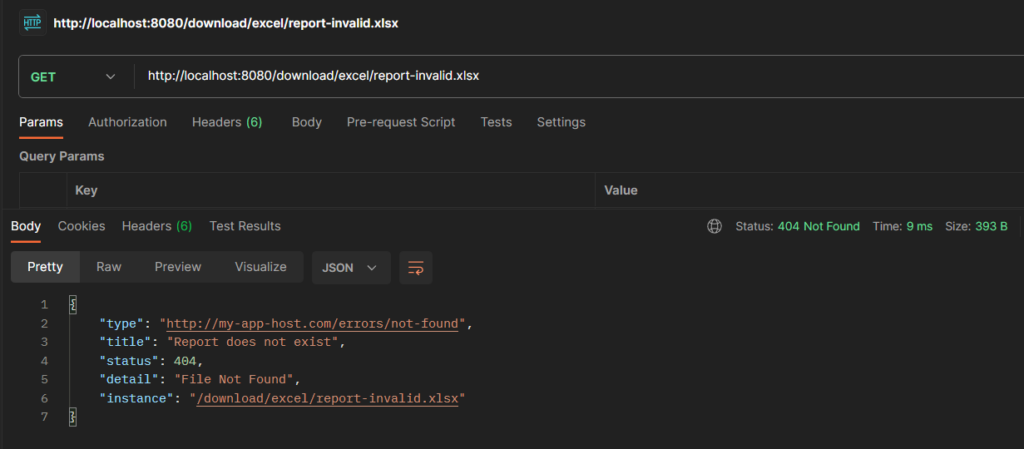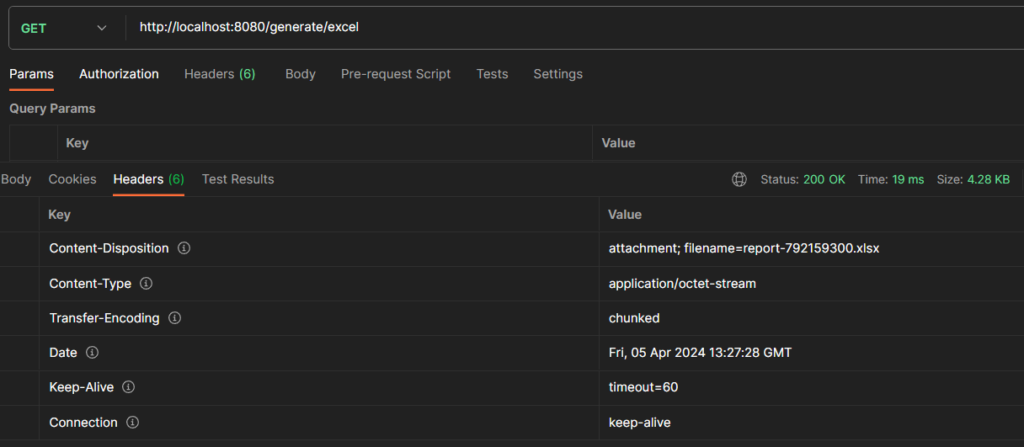In this quick and easy-to-follow Spring boot tutorial, we are writing REST APIs that can be used for downloading Excel files from the server. We are writing two types of API:
- REST API to download a static Excel file stored on the server.
- REST API to generate the Excel report and then download it.
Note that report generation should be done for really small files because if it takes time then the user interface can become unresponsive. Ideally, the reports should be generated by a batch process or later the file should be available for download.
1. Downloading a Static Excel File Stored in the Server
The following REST API takes the filename from the user and searches it in a specific location (in this case ‘c:/temp/’ directory). If the file is not found or the file size exceeds the preconfigured limit, the REST returns the error using the latest ProblemDetail specification. Also notice that the response content type has been set to application/octet-stream.
If the file is found and other conditions are met, the file is written the response and it is downloaded into the user’s browser.
import org.springframework.core.io.InputStreamResource;
import org.springframework.http.*;
import org.springframework.stereotype.Controller;
import org.springframework.web.bind.annotation.GetMapping;
import org.springframework.web.bind.annotation.PathVariable;
import java.io.IOException;
import java.net.URI;
import java.nio.file.Files;
import java.nio.file.Path;
import java.nio.file.Paths;
@Controller
public class ExcelDownloadController {
private static final String FILE_DIRECTORY = "c:/temp/";
@GetMapping("/download/excel/{fileName}")
public ResponseEntity<?> downloadFile(@PathVariable String fileName) {
// Construct file path
String filePath = FILE_DIRECTORY + fileName;
try {
// Check if file exists
Path file = Paths.get(filePath);
if (!Files.exists(file)) {
ProblemDetail pd = ProblemDetail.forStatusAndDetail(HttpStatus.NOT_FOUND, "File Not Found");
pd.setType(URI.create("http://my-app-host.com/errors/not-found"));
pd.setTitle("Report does not exist");
return ResponseEntity.status(HttpStatus.NOT_FOUND).body(pd);
}
// Check file size
long fileSize = Files.size(file);
if (fileSize > 10 * 1024 * 1024) { // 10 MB
ProblemDetail pd = ProblemDetail.forStatusAndDetail(HttpStatus.BAD_REQUEST, "File Size Exceeded");
pd.setType(URI.create("http://my-app-host.com/errors/report-size-limits"));
pd.setTitle("Report size exceed the limit");
return ResponseEntity.status(HttpStatus.BAD_REQUEST).body(pd);
}
// Read file into InputStreamResource
InputStreamResource resource = new InputStreamResource(Files.newInputStream(file));
// Set response headers
HttpHeaders headers = new HttpHeaders();
headers.add(HttpHeaders.CONTENT_DISPOSITION, "attachment; filename=" + fileName);
return ResponseEntity.ok()
.headers(headers)
.contentType(MediaType.APPLICATION_OCTET_STREAM)
.body(resource);
} catch (Exception e) {
// Handle all other errors
ProblemDetail pd = ProblemDetail.forStatusAndDetail(HttpStatus.INTERNAL_SERVER_ERROR, "Server Error");
pd.setType(URI.create("http://my-app-host.com/errors/misc"));
pd.setTitle("Server Error");
return ResponseEntity.status(HttpStatus.INTERNAL_SERVER_ERROR).body(pd);
}
}
}We can verify the API in the browser by requesting an invalid file and then a valid file.
Invalid File Name:

Valid File Name:

2. Generating an Excel File and Downloading It
When we need to generate the Excel report in runtime, only the part related to locating the static file is changed. Additionally, we have to add the report generation logic.
Consider the following REST API that does the following:
- Creates a new file with the unique name in the server
- Process the report data and write to the file
- Write the file into the API response
import org.dhatim.fastexcel.Workbook;
import org.dhatim.fastexcel.Worksheet;
import org.springframework.core.io.InputStreamResource;
import org.springframework.http.*;
import org.springframework.stereotype.Controller;
import org.springframework.web.bind.annotation.GetMapping;
import java.io.FileOutputStream;
import java.io.IOException;
import java.io.OutputStream;
import java.net.URI;
import java.nio.file.Files;
import java.nio.file.Path;
import java.nio.file.Paths;
import java.time.LocalDateTime;
@Controller
public class ExcelDownloadController {
@GetMapping("/generate/excel")
public ResponseEntity<?> generateExcel() {
try {
// Read file into InputStreamResource
String filePath = getExcelReport();
Path path = Paths.get(filePath);
String fileName = path.getFileName().toString();
InputStreamResource resource = new InputStreamResource(Files.newInputStream(path));
// Set response headers
HttpHeaders headers = new HttpHeaders();
headers.add(HttpHeaders.CONTENT_DISPOSITION, "attachment; filename=" + fileName);
return ResponseEntity.ok()
.headers(headers)
.contentType(MediaType.APPLICATION_OCTET_STREAM)
.body(resource);
} catch (Exception e) {
// Handle other errors
ProblemDetail pd = ProblemDetail.forStatusAndDetail(HttpStatus.INTERNAL_SERVER_ERROR, "Server Error");
pd.setType(URI.create("http://my-app-host.com/errors/misc"));
pd.setTitle("Server Error");
return ResponseEntity.status(HttpStatus.INTERNAL_SERVER_ERROR).body(pd);
}
}
private String getExcelReport() throws IOException {
String fileName = "report-" + LocalDateTime.now().getNano() + ".xlsx";
String fileLocation = "c:/temp/" + fileName;
try (OutputStream os = new FileOutputStream(fileLocation)) {
Workbook wb = new Workbook(os, fileName, "1.0");
Worksheet ws = wb.newWorksheet("Sheet 1");
//Writing some dummy data for testing
ws.value(0, 0, "Column 1");
ws.value(0, 1, "Column 2");
ws.value(0, 2, "Column 3");
ws.value(0, 3, "Column 4");
ws.value(0, 4, "Column 5");
ws.value(0, 5, "Column 6");
ws.value(0, 6, "Column 7");
ws.value(0, 7, "Column 8");
ws.value(0, 8, "Column 9");
ws.value(0, 9, "Column 10");
for (int i = 1; i < 10; i++) {
String value = "data-" + i;
ws.value(i, 0, i);
ws.value(i, 1, value);
ws.value(i, 2, value);
ws.value(i, 3, value);
ws.value(i, 4, value);
ws.value(i, 5, value);
ws.value(i, 6, value);
ws.value(i, 7, value);
ws.value(i, 8, value);
ws.value(i, 9, value);
}
wb.finish();
} catch (Exception e) {
throw new RuntimeException("Error while creating the Excel Report", e);
}
return fileLocation;
}
}Now we can test this report by accessing the API URL in the browser:

3. Conclusion
In this short Spring Boot tutorial, we have learned to write Spring Boot RESTs that help in downloading the Excel files either stored in the server or generating them in runtime before sending in the response.
The APIs given above are meant to be for quick start only, and we should follow the project-specific guidelines for writing code and using file locations.
Feel free to modify the code according to your project needs.
Happy Learning !!


Comments